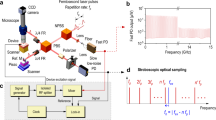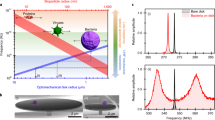Abstract
The question of whether sound vibration of a medium can bring about any kind of molecular or macromolecular events is a long-standing scientific controversy. Although it is known that ultrasonic vibrations with frequencies of more than 1 MHz are able to align certain macromolecules in solution, no effect has yet been reported with audible sound, the frequency of which is much lower (20–20,000 Hz). Here, we report on the design of a supramolecular nanofibre that in solution becomes preferentially aligned parallel to the propagation direction of audible sound. This phenomenon can be used to spectroscopically visualize sound-induced vibrations in liquids and may find application in a wide range of vibration sensing technologies.
This is a preview of subscription content, access via your institution
Access options
Subscribe to this journal
Receive 12 print issues and online access
$259.00 per year
only $21.58 per issue
Buy this article
- Purchase on Springer Link
- Instant access to full article PDF
Prices may be subject to local taxes which are calculated during checkout






Similar content being viewed by others
References
Beranek, L. L. Acoustics (McGraw-Hill, 1954).
Komatsu, A. Food Science Journal [in Japanese] 203, 52–62 (1995).
Shilton, R., Tan, M. K., Yeo, L. Y. & Friend, J. R. Particle concentration and mixing in microdrops driven by focused surface acoustic waves. J. Appl. Phys. 104, 014910 (2008).
Alvarez, M., Friend, J. R. & Yeo, L. Y. Surface vibration induced spatial ordering of periodic polymer patterns on a substrate. Langmuir 24, 10629–10632 (2008).
Friend, J. R., Yeo, L. Y., Arifin, D. R. & Mechler, A. Evaporative self-assembly assisted synthesis of polymeric nanoparticles by surface acoustic wave atomization. Nanotechnology 19, 145301 (2008).
Kawamura, H. Kagaku [in Japanese] 7, 6–7 (1938).
Lipeles, R. & Kivelson, D. Experimental studies of acoustically induced birefringence. J. Chem. Phys. 72, 6199–6208 (1980).
Yasuda, K., Matsuoka, T., Koda, S. & Nomura, H. Dynamics of V2O5 sol by measurement of ultrasonically induced birefringence. Jpn J. Appl. Phys. 33, 2901–2904 (1994).
Yasuda, K., Matsuoka, T., Koda, S. & Nomura, H. Dynamics of entanglement networks of rodlike micelles studied by measurements of ultrasonically induced birefringence. J. Phys. Chem. B 101, 1138–1141 (1997).
Nomura, H., Matsuoka, T. & Koda, S. Ultrasonically induced birefringence in polymer solutions. Pure Appl. Chem. 76, 97–104 (2004).
Yamaguchi, T., Kimura, T., Matsuda, H. & Aida, T. Macroscopic spinning chirality memorized in spin-coated films of spatially designed dendritic zinc porphyrin J-aggregates. Angew Chem. Int. Ed. 43, 6350–6355 (2004).
Tsuda, A. et al. Spectroscopic visualization of dynamic vortex flows using a dye-containing nanofiber. Angew Chem. Int. Ed. 46, 8198–8202 (2007).
Wolffs, M. et al. Macroscopic origin of circular dichroism effects by alignment of self-assembled fibers in solution. Angew. Chem. Int. Ed. 46, 8203–8205 (2007).
de Greef, T. F. A. & Meijer, E. W. Supramolecular polymers. Nature 453, 171–173 (2008).
Chen, Z., Lohr, A., Saha-Möller, C. R. & Würthner, F. Self-assembled π-stacks of functional dyes in solution: structural and thermodynamic features. Chem. Soc. Rev. 38, 564–584 (2009).
Chi, X., Guerin, A. J., Haycock, R. A., Hunter, C. A. & Sarson, L. D. Self-assembly of macrocyclic porphyrin oligomers. Chem. Commun. 2567–2568 (1995).
Tsuda, A., Nakamura, T., Sakamoto, S., Yamaguchi, K. & Osuka, A. A self-assembled porphyrin box from meso-meso-linked bis{5-p-pyridyl-15-(3,5-di-octyloxyphenyl)porphyrinato zinc(II)}. Angew Chem. Int. Ed. 41, 2817–2821 (2002).
Fukushima, K. et al. Synthesis and properties of Rhodium(III) porphyrin cyclic tetramer and cofacial dimer. Inorg. Chem. 42, 3187–3193 (2003).
Tsuda, A., Hu, H., Tanaka, R. & Aida, T. Planar or perpendicular? Conformational preferences of π-conjugated metalloporphyrin dimers and trimers in supramolecular tubular arrays. Angew Chem. Int. Ed. 44, 4884–4888 (2005).
Aimi, J. et al. ‘Conformational’ solvatochromism: spatial discrimination of nonpolar solvents using a supramolecular box of a π-conjugated zinc bisporphyrin rotamer. Angew Chem. Int. Ed. 47, 5153–5156 (2008).
Shi, X., Barkigia, K. M., Fajer, J. & Drain, C. M. Design and synthesis of porphyrins bearing rigid hydrogen bonding motifs: highly versatile building blocks for self-assembly of polymers and discrete arrays. J. Org. Chem. 66, 6513–6522 (2001).
Shoji, O., Tanaka, H., Kawai, T. & Kobuke, Y. Single molecule visualization of coordination-assembled porphyrin macrocycles reinforced with covalent linkings. J. Am. Chem. Soc. 127, 8598–8599 (2005).
Michelsen, U. & Hunter, C. A. Self-assembled porphyrin polymers. Angew Chem. Int. Ed. 39, 764–767 (2000).
Ogawa, K. & Kobuke, Y. Formation of a giant supramolecular porphyrin array by self-coordination. Angew Chem. Int. Ed. 39, 4070–4073 (2000).
Hameren, R. V. et al. Macroscopic hierarchical surface patterning of porphyrin trimers via self-assembly and dewetting. Science 314, 1433–1436 (2006).
Wang, Z., Medforth, C. J. & Shelnutt, J. A. Porphyrin nanotubes by ionic self-assembly. J. Am. Chem. Soc. 126, 15954–15955 (2004).
Stupp, S. I. et al. Supramolecular materials: self-organized nanostructures. Science 276, 384–389 (1997).
Hirschberg, J. H. K. K. et al. Helical self-assembled polymers from cooperative stacking of hydrogen-bonded pairs. Nature 407, 167–170 (2000).
Rajendra, J., Baxendale, M., Rap, L. G. T. & Rodger, A. Flow linear dichroism to probe binding of aromatic molecules and DNA to single-walled carbon nanotubes. J. Am. Chem. Soc. 126, 11182–11188 (2004).
Adachi, K. & Watarai, H. Two-phase Couette flow linear dichroism measurement of the shear-forced orientation of a palladium(II)-induced aggregate of thioether-derivatized subphthalocyanines at the toluene/glycerol interface. New J. Chem. 30, 343–348 (2006).
Marrington, R. et al. Validation of new microvolume Couette flow linear dichroism cells. Analyst 130, 1608–1616 (2005).
Yoshimura, T., Sakashita, H. & Wakabayashi, N. Real-time measurements of spatial velocity distribution with a laser Doppler imaging system. Appl. Opt. 22, 2448–2452 (1983).
Yoshida, N., Aratani, N. & Osuka, A. Poly(zinc(II)-5,15-porphyrinylene) from silver(I)-promoted oxidation of zinc(II)-5,15-diarylporphyrins. Chem. Commun. 197–198 (2000).
Acknowledgements
The present work was sponsored by a Grant-in-Aid for Scientific Research (B) (no. 22350061) from the Ministry of Education, Science, Sports and Culture, Japan, by JST, Research Seeds Program, by Hyogo Science and Technology Association and by TEPCO Research Foundation.
Author information
Authors and Affiliations
Contributions
A.T. conceived and directed the project, contributed to all experiments, and wrote the paper. Y.N. and R.W. performed syntheses and spectroscopic studies. Y.N. carried out characterization of aerial sound waves. N.I. carried out TEM measurements. T.A. directed the study and contributed to the execution of the experiments and interpretation of results.
Corresponding authors
Ethics declarations
Competing interests
The authors declare no competing financial interests.
Supplementary information
Supplementary information
Supplementary information (PDF 1290 kb)
Supplementary information
Supplementary movie S1 (MOV 7720 kb)
Rights and permissions
About this article
Cite this article
Tsuda, A., Nagamine, Y., Watanabe, R. et al. Spectroscopic visualization of sound-induced liquid vibrations using a supramolecular nanofibre. Nature Chem 2, 977–983 (2010). https://doi.org/10.1038/nchem.825
Received:
Accepted:
Published:
Issue Date:
DOI: https://doi.org/10.1038/nchem.825
This article is cited by
-
Cascade reaction networks within audible sound induced transient domains in a solution
Nature Communications (2022)
-
Audible sound-controlled spatiotemporal patterns in out-of-equilibrium systems
Nature Chemistry (2020)
-
A sound approach to self-assembly
Nature Chemistry (2020)
-
Chain growth in control
Nature Chemistry (2015)



